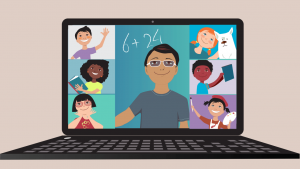The Function of E-Learning in Forming the Future of Education And Learning for Kids
As traditional education systems advance, the integration of e-learning is arising as a critical pressure in shaping the future of education for kids. Via interactive platforms, customized finding out paths, and improved ease of access, e-learning addresses diverse academic requirements while fostering important thinking skills. This electronic transformation not just bridges geographical separates but likewise makes sure fair access to high quality education, establishing the phase for a more inclusive understanding environment. Comprehending the full level of this impact requires analyzing the complex effects of e-learning's role in contemporary education and learning systems.
Interactive Learning Settings
In the realm of e-learning for children, interactive learning environments have actually become crucial devices in boosting educational outcomes. Education and study for children and kids. These electronic platforms incorporate multimedia components such as videos, computer animations, and gamified workouts to develop a appealing and vibrant instructional experience. Especially, they transform passive learning right into an energetic procedure, thus fostering far better retention and understanding

Virtual class and conversation online forums allow trainees to share ideas, ask questions, and team up on jobs, replicating the benefits of traditional class communications. Interactive understanding settings are not just extra instructional devices yet necessary elements that enrich the finding out ecological community for kids.
Customized Education Paths
Utilizing the possibility of tailored education courses changes the discovering experience for children by dealing with their unique demands and capabilities. Traditional one-size-fits-all strategies commonly stop working to deal with specific understanding spaces and staminas. E-learning platforms, nonetheless, can use sophisticated formulas and data analytics to customize instructional material, pace, and techniques to each kid's specific demands. This customization fosters a more appealing and effective discovering environment, allowing students to grow at their very own pace.
Individualized education paths also equip instructors by giving detailed insights into trainee development. Teachers can identify areas where a kid may interfere and struggle with targeted support. On the other hand, pupils mastering particular subjects can advance without being held back by a standardized curriculum. This adaptability not only improves academic performance but also increases trainee confidence and motivation.
Moreover, e-learning systems can incorporate diverse learning sources, such as interactive simulations, multimedia web content, and gamified lessons, to straighten with various discovering designs. By fitting visual, auditory, and kinesthetic students, individualized education and learning paths ensure that each youngster obtains one of the most efficient instructional methods. Education and study for children and kids. Hence, leveraging personalized education and learning paths through e-learning is instrumental in creating a future-proof, comprehensive, and effective educational landscape for youngsters
Enhancing Availability
While the benefits of personalized education and learning courses are substantial, improving availability is equally crucial to make certain that e-learning platforms can get to all kids, irrespective of their socio-economic history or geographic area. Digital addition is necessary to bridge the instructional divide and supply equitable understanding possibilities. This can be accomplished through the growth of inexpensive, high-grade e-learning solutions that are obtainable on diverse gadgets, including smartphones, tablets, and computers.
Moreover, collaborations between governments, non-profits, and private markets can facilitate the distribution of required innovation and net access to underserved communities. Such partnerships can additionally support the production of local content in various languages, making sure social importance and understanding.
Furthermore, adaptive understanding technologies can be tailored to accommodate children with impairments, offering functions like text-to-speech, adjustable message sizes, and interactive elements that accommodate various learning needs. These developments not only democratize education however likewise equip learners by offering tools that cater to specific obstacles.
Developing Important Skills
With availability improvements in area, the following critical aspect to address is the growth of his comment is here crucial abilities among young learners. E-learning systems provide a special possibility to grow an array of essential abilities that typical classroom settings might have a hard time to deal with comprehensively. Amongst these are essential reasoning, problem-solving, and electronic literacy, which are increasingly indispensable in the modern-day world.

In addition, e-learning platforms commonly include collective devices like discussion forums, team projects, and peer reviews, which promote interaction and team effort abilities. These platforms likewise reveal students to a huge array of digital devices and sources, improving their digital literacy. As trainees browse various software, apps, and on-line sources, they end up being adept at making use of technology properly and responsibly.
Fundamentally, e-learning not just supplements traditional education yet also furnishes students with the important abilities necessary to thrive in a significantly electronic and interconnected world.
Conquering Geographical Barriers
The introduction of e-learning has dramatically mitigated the geographical barriers that typically impeded accessibility to top quality education. Prior to the digital transformation, trainees in impoverished or remote locations usually encountered minimal academic sources and chances. E-learning platforms now connect this gap, providing universal accessibility to top quality instructional content no matter of place.
Through online classes, digital collections, and interactive tools, students from varied geographical histories can engage with the same educational program supplied in municipal colleges. This democratization of education and learning makes sure that every kid, regardless of their physical place, has the prospective to achieve scholastic success. E-learning facilitates accessibility to specific topics and skilled instructors that her response might not be readily available locally.
Moreover, e-learning makes it possible for real-time partnership in between trainees and teachers from various parts of the globe, promoting an international discovering community. This interconnectedness not just enriches pupils' academic experiences but likewise prepares them for a much more globalized labor force. By getting over geographical constraints, e-learning is crucial in producing a comprehensive educational setting where every child has the chance to thrive. For that reason, the duty of e-learning extends beyond plain benefit; it is a transformative device that redefines ease of access in education and learning.
Conclusion
E-learning is essential fit the future of education and learning for children by producing interactive and tailored discovering settings. It boosts accessibility, promotes important ability advancement, and gets rid of geographical barriers, guaranteeing all trainees access to top notch educational resources. This digital transformation outfits students with the devices required for expert and academic success, promoting inclusivity and collaboration on a global scale. E-learning, as a result, stands as a foundation in the development of contemporary education.
As typical education and learning systems develop, the combination of e-learning is emerging as a critical pressure in forming the future of education and learning for kids. Thus, leveraging personalized education and learning courses with e-learning is instrumental in creating a future-proof, comprehensive, and effective academic landscape for children.
While the benefits of individualized education and learning paths are considerable, improving availability is similarly important to guarantee that e-learning platforms can reach all children, regardless of their socio-economic history or geographic place. The function of read this e-learning extends beyond plain comfort; it is a transformative tool that redefines ease of access in education.
E-learning is crucial in forming the future of education for children by creating tailored and interactive discovering atmospheres.